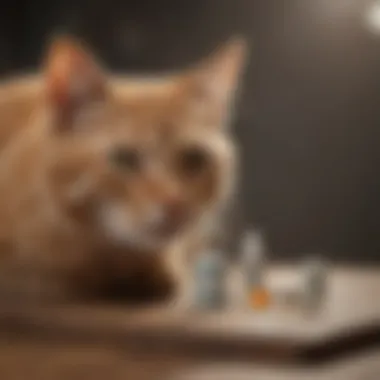Advancements in Cat Flea and Tick Treatments


Intro
Flea and tick treatments for cats have come a long way. What once seemed like an uphill battle against tiny, parasitic foes is now evolving into a landscape filled with innovative solutions. As our understanding of these pests grows, so does our capability to manage them effectively. This transformation not only benefits the health of our feline friends but also addresses the environmental concerns surrounding pet care.
Historically, dealing with fleas and ticks meant relying on a limited selection of products that might have potentially harmful side effects. Today's options are more refined and targeted, emphasizing safety and sustainability. As we take a closer look at this evolution, we'll explore where we’ve been, what current advances are shaping the industry, and what the future holds for both our pets and the planet.
Overview of Flea and Tick Infestations
Flea and tick infestations represent a pressing concern for cat owners, impacting not only the well-being of beloved pets but also the household environment. Understanding these pests is paramount in ensuring effective treatment and prevention strategies. This overview sets the stage for a deeper exploration of the intricacies involved in flea and tick management, giving owners the insight needed to safeguard their feline friends.
Understanding Fleas and Ticks
Fleas and ticks are more than just pesky annoyances; they’re parasites that thrive on the blood of their hosts.
- Fleas: These small, wingless insects are known for their agility and ability to reproduce rapidly, laying hundreds of eggs that can quickly lead to an infestation.
- Ticks: Unlike fleas, ticks are arachnids, often hiding in tall grass or bushes. They attach themselves to hosts and can transmit various diseases.
The life cycles of these parasites can vary greatly but generally include egg, larva, pupa, and adult stages for fleas. For ticks, the life cycle comprises egg, larva, nymph, and adult stages. Both can linger in the environment and can jump onto pets from surrounding areas.
Common Symptoms and Detection
Recognizing the symptoms of flea and tick infestations is crucial for timely intervention. Felines can exhibit various signs, including:
- Scratching and Grooming: Intensified scratching, biting, or grooming often signals a flea or tick presence.
- Skin Irritation: Look for red or inflamed skin, hot spots, or hair loss in areas where the pet has been scratching.
- Fleas or Ticks: The presence of fleas may be evident from flea dust (tiny black specks) in the fur, while ticks can often be seen crawling or embedded in the skin.
- Behavioral Changes: Restless behavior, frequent hiding, or changes in appetite might also indicate infestations.
An owner’s familiarity with these signs promotes prompt action, reducing health risks to the pet and the household.
Impacts on Cat Health
The implications of flea and tick infestations on a cat’s health extend beyond mere discomfort.
- Anemia: Heavy flea infestations can lead to anemia in cats, particularly in kittens or old cats, as they lose significant blood.
- Skin Infections: The incessant scratching can create open wounds, inviting secondary infections.
- Diseases: Ticks are notorious for transmitting diseases like Lyme disease or Babesiosis, which can have long-term health consequences for pets.
In essence, the battle against fleas and ticks is not just about control; it's about maintaining the health and happiness of our feline companions. Awareness and understanding empower pet owners to take action, ensuring their cats remain safe from these unwanted invaders.
Historical Perspectives on Treatments
Understanding the historical context of flea and tick treatments for cats offers a broader perspective on how far we've come in ensuring the health and wellbeing of our feline companions. Throughout history, the battle against these pests has shaped various practices and products, many of which laid the groundwork for modern treatments. The significance of exploring these past remedies lies in recognizing the evolution of thought and practice that contributes to what is available on the market today. By peering into the past, we also gain insights into the benefits, limitations, and cultural factors that influenced early pest control methods, some of which are still relevant today.
Traditional Remedies Past
In ancient times, pet owners relied heavily on natural resources to combat fleas and ticks. Ingredients were often sourced from the environment, utilizing herbs and plants known for their pest-repelling properties. For instance, a common remedy involved using a mixture of neem oil and coconut oil. This blend was believed to repel fleas due to the natural properties of the neem tree, known as Azadirachta indica.
Not only were these methods cost-effective, but they also aligned with a holistic view of pet care, as they prioritized the well-being of the pet and the environment. However, while many traditional remedies provided some level of relief, they often lacked the rigor and consistency that modern science offers.
Pharmaceutical Developments


The 20th century marked a substantial shift in the treatment of fleas and ticks with the advent of synthetic medications. As pharmaceutical advancements unfolded, treatments evolved from simple oils and powders to complex formulations specifically engineered to target parasites while minimizing side effects.
For example, the introduction of fipronil and imidacloprid brought forth a new era of topical treatments. These products demonstrated significant efficacy, allowing cat owners to address infestations more effectively than ever. The rise of oral medications also transformed the landscape, making it easier for pet owners to administer treatments without stressful applications. The pharmaceutical developments not only brought better solutions but also expanded knowledge on the life cycles of these pests, allowing for more precise targeting.
Community Practices and Wisdom
While scientific advancements rule the modern landscape, local communities often hold onto traditional wisdom passed down through generations. For example, many cat owners in rural areas still use homemade concoctions like diluted apple cider vinegar, believing it provides a natural barrier against fleas when sprayed onto the fur.
Such practices emphasize a blend of personal experience and cultural understanding. Pet owners often trust these time-honored solutions due to the value of community knowledge and anecdotal evidence. Additionally, community-led initiatives, such as flea and tick awareness campaigns, have grown, merging traditional practices with modern insights. This grassroots approach demonstrates how community wisdom can coexist with scientific advancements, ultimately guiding choices about pet care.
"In the web of history, every thread of knowledge has contributed to the rich tapestry of today’s pest control."
Through understanding these varied perspectives on flea and tick treatments, one can appreciate the intricate balance between nature and science that shapes the current options available for our beloved cats.
The Modern Revolution in Flea and Tick Medicine
The landscape of flea and tick treatments for cats has witnessed significant changes recently. Gone are the days of generic, one-size-fits-all solutions. Now, the focus is on specificity and effectiveness, which has brought about a modern revolution in veterinary medicine. As pet owners become more aware of the health risks associated with pests, treatments are evolving to be safer for both felines and the environment. This section will dive into how new formulations, species-specific needs, and the integration of treatments into veterinary practice are shaping this revolution.
Innovative Formulations
Oral Treatments
Oral treatments have taken the stage as a favored choice among cat owners. One of their standout characteristics is ease of administration. Many cats, known for their pickiness, may resist topical applications, but they often accept oral medications quite willingly. This contributes to their growing popularity, as they’re often seen as a hassle-free option for busy pet owners.
A unique aspect of oral treatments is their systemic efficacy; they work from the inside out, providing protection that might last longer than some topical products. However, a potential downside is that many of these treatments require the pet to ingest the entire dose, which can be challenging if the cat is particularly finicky about food.
Topical Solutions
Topical solutions offer another layer of versatility in the fight against fleas and ticks. These are typically applied directly onto the cat's skin, making them a practical choice for many pet owners. The key characteristic of topical solutions is their quick action; they often work within hours of application, providing immediate relief. One unique feature is the variety in formulations, catering to different lifestyles and needs. For instance, there are options that can repel additional pests like mosquitoes, which can be particularly useful in certain climates. On the flip side, topical treatments can wash off with water, making them less effective for cats that enjoy baths or swimming.
Long-Lasting Treatments
The market has increasingly leaned towards long-lasting treatments, aiming to reduce the frequency of applications. These treatments focus on delivering sustained protection; some offer protection for up to three months or longer. This convenience is truly a game-changer for pet owners who often juggle busy schedules.
A significant characteristic of these long-lasting options is their ability to minimize the chance of infestation peaks, creating a more comfortable environment for cats. However, a downside to consider is that some of these products may carry higher costs and may require proper consultation to ensure safety according to individual pet needs.
Targeting Species-Specific Needs
As veterinary science advances, there has been a growing awareness of the necessity to cater treatments to specific breeds and sizes of cats. Each type of kitty has unique biological and behavioral traits which affect how they react to medications. For example, a tiny domestic shorthair could have significantly different needs compared to a large Maine Coon.
Now, manufacturers have started to design products that address these differences, ensuring that each cat has access to treatment that best suits its specific body weight and lifestyle. This shift in focus will not only yield better outcomes but also enhance safety.
Integration with Veterinary Practices
Another critical aspect of this modern revolution is the partnership between product manufacturers and veterinary practices. Veterinarians now have an expanded range of treatments to discuss with pet owners. Rather than solely relying on over-the-counter solutions, vets can recommend products based on thorough assessments of pet needs and environment. This tailored approach increases the likelihood of successfully managing flea and tick infestations.
Moreover, veterinarians often provide insights into behavioral evaluations, helping owners to understand how their cat interacts with different treatments. This comprehensive care is a vital part of the journey towards healthier, happier pets.
"The evolution of flea and tick treatments isn’t just about the products; it’s about how we care for our pets holistically."
By understanding these modern developments, cat owners can effectively navigate the myriad of options available and choose the best treatment strategy suited to their feline companions.


Safety and Efficacy of Current Treatments
Ensuring the safety and effectiveness of flea and tick treatments for cats is paramount. Pet owners not only want to rid their beloved companions of pests but also wish to avoid adverse reactions that could harm their cats. With a plethora of products on the market, understanding what makes these treatments both safe and effective is essential for responsible pet care.
Clinical Trials and Approvals
Clinical trials play a crucial role in the development of flea and tick medications. These trials are not just a box-ticking exercise; they provide substantial evidence to affirm the safety and efficacy of treatments before they hit the shelves. During these tests, various dosages and formulations undergo rigorous assessments to evaluate their performance against both fleas and ticks. The approval process involves various regulatory bodies who scrutinize the results before granting permission for commercial sale. For instance, treatments like Revolution and Advantage have gone through extensive trials, ensuring they are rigorous enough to handle common infestations effectively.
Assessing Side Effects and Reactions
While many treatments have proven effective, it’s also critical to consider their side effects. Cats can manifest various reactions, ranging from minor irritations to significant health issues. For instance, some topical solutions may lead to skin irritations. By monitoring reactions, both veterinarians and pet owners can better understand how their cats are responding to different products. In cases where adverse effects occur, switching to another product or adjusting the dosage may be necessary. Always keeping a close watch on the cat's behavior post-application is a good practice.
Monitoring Pet Health Post-Treatment
Once a flea or tick treatment is administered, ongoing monitoring of the cat's health is vital. This step cannot be overstated. Engaging veterinarians for regular check-ups allows for the early detection of any possible complications arising from treatments. Additionally, maintaining a journal documenting the application's effects on the cat may also help identify trends over time—whether the treatment is consistently successful or if adjustments are needed. A well-planned follow-up can lead not only to a happier cat but also peace of mind for the owner.
"Regular monitoring of your pet post-treatment can catch unnoticed side effects early and lead to timely interventions."
In sum, while modern flea and tick treatments for cats have come a long way, understanding their safety and efficacy is essential for building trust in their use. With clinical trials providing a backbone for their development, awareness of side effects, and commitment to monitoring health post-treatment, cat owners can make informed decisions that enhance their pets' well-being.
Environmental Considerations
The conversation surrounding flea and tick treatments has shifted significantly in recent years to include a strong focus on environmental considerations. As pet owners become more conscientious about their choices, understanding how treatments affect the ecosystem becomes vital. Many chemical treatments, while effective against parasites, raise concerns regarding their long-term impact on various environmental aspects. It’s not only about keeping our feline friends comfortable but also ensuring that the solutions we employ do not harm the delicate balance of nature.
Impact of Chemicals on the Ecosystem
The widespread use of chemical treatments has led to noticeable repercussions in the ecosystem. When these products are used, they don’t just target fleas and ticks; they can also impact other insects, plants, and even larger wildlife. For instance, the runoff from treated areas can contaminate soil and water sources, affecting local flora and fauna. In some cases, specific chemicals can cause a decline in beneficial insect populations, which are crucial for pollination and pest control. Consequently, prolonged exposure to these chemicals can lead to a disruption of local ecosystems, which is a poignant reminder that our choices as pet owners do extend beyond our household.
Sustainable Alternatives
As environmental concerns mount, there's been a concerted push towards sustainable alternatives. These methods not only provide pet owners with effective tools against fleas and ticks but also minimize detrimental impacts on the environment.
Natural Repellents
Natural repellents are gaining traction among pet owners, and they stand out for several reasons. One prominent feature is that they use naturally occurring substances that are often less harmful to the environment compared to synthetic treatments. Examples include essential oils such as lavender and peppermint. These oils repel insects without the risks associated with harsher chemicals. The main selling point for many pet owners is that they provide peace of mind, knowing they are not introducing toxic substances into their home or yard. However, it's essential to use natural repellents correctly, as some essential oils can be toxic to cats if used in high concentrations or improperly.
Integrated Pest Management
Integrated Pest Management, or IPM, is another holistic approach that focuses on long-term solutions instead of immediate fixes. This strategy combines multiple pest control methods, including biological, mechanical, and chemical tools, while emphasizing prevention. The key characteristic of IPM is its adaptability; it encourages pest control methods tailored to the specific environment and circumstances. This is particularly beneficial because it reduces reliance on any single type of treatment, thereby limiting chemical usage and promoting biodiversity. One drawback to consider is that IPM may require more time and effort to establish compared to straightforward chemical solutions, but the long-term benefits often outweigh these challenges.
"Sustainable practices in pest management not only protect our pets but also our planet for future generations."
Guidelines for Responsible Use of Treatments
In today's world, where information is at our fingertips, knowing how to properly use flea and tick treatments on cats is more critical than ever. With a myriad of products lining the shelves, it’s easy to get overwhelmed. This section explores the fundamental guidelines for responsible use, emphasizing key considerations that promote the well-being of both pets and the environment.


Understanding Product Labels
Product labels serve as a roadmap, guiding us through the various treatments available. Each label is packed with essential information, including active ingredients, usage instructions, and potential side effects. Here are a few vital elements to keep in mind:
- Active Ingredients: What’s doing the heavy lifting? Knowing how each ingredient works can help you choose the best product. For instance, ingredients like fipronil and imidacloprid may be commonly found in topical treatments, but they have different mechanisms of action.
- Dosage Instructions: Read these carefully. Administering improper dosages can lead to ineffective treatment or harmful reactions. It's not just about whether your cat is a kitten or an adult; weight plays a huge role in determining the right dose.
- Warnings and Precautions: Labels typically include specific warnings, especially for households with children or other pets. Following these precautions closely avoids complications later on.
Keeping abreast of these labels not only safeguards your cat but also fosters responsible pet ownership.
Best Practices for Application
Applying treatments effectively is crucial to ensuring their efficacy. Here are some practices to consider:
- Choose the Right Time: Applying certain treatments while your cat is in a calm state is advisable. If your feline is jittery, wait until they are relaxed to prevent unnecessary strain.
- Clean Environment: Ensuring that your cat's resting areas are clean helps. You wouldn’t want old flea dirt mixing with fresh treatments, defeating the purpose of application.
- Follow the Steps: Whether it's a topical solution or an oral treatment, always adhere strictly to the application steps outlined on the label. Even minor deviations can render the treatment ineffective.
- Wash Hands: After applying any medication, make sure to wash your hands thoroughly. Cat treatments can be toxic to humans in certain doses, so prevention is key.
Getting these basics down pat sets the stage for successful treatment outcomes and keep those pesky pests at bay.
Consulting with Veterinarians
The veterinarian is your trusted partner when it comes to pet health. Their expertise can effectively guide you throughout the treatment process. Here’s why consulting a vet is often the best course of action:
- Tailored Recommendations: Each cat is unique. An experienced vet will assess your pet’s specific needs, taking into account their age, health history, and lifestyle. This personalized advice can be invaluable.
- Safety Concerns: Some products may react differently for cats with pre-existing conditions or those on other medications. A vet can help to avoid detrimental interactions.
- Preventative Care: Beyond just treating infestations, vets can offer insights on preventive measures, tweaking your treatment plan over time for better outcomes.
To make the most of your veterinary consultations, come prepared with questions. This ensures a comprehensive understanding of your cat's needs and fosters a cooperative partnership in pet care.
"Consultation is not just about medicating; it's about understanding the whole pet."
In summary, recognizing the importance of responsible use of flea and tick treatments is vital. By understanding product labels, following application practices, and consulting with veterinarians, you can significantly enhance your cat's well-being while ensuring a safer environment. This holistic approach not only benefits your furry friend but also aligns with evolving standards in pet care.
Future Directions in Flea and Tick Medicine
In the landscape of veterinary medicine, the evolution of flea and tick treatments is more than just a matter of convenience. It reflects a deeper understanding of feline health and the proactive measures that pet owners can take for their furry friends. As we look ahead, it's pivotal to consider how emerging trends and innovative practices will shape the future of flea and tick management. In this section, the focus will be on advancements that promise to make treatments more effective and safer for both cats and the environment.
Emerging Research and Innovations
The frontiers of research in flea and tick medicine are pushing boundaries. New formulations are being developed every day, with an increasing emphasis on targeted treatment. For instance, scientists are exploring the use of biocontrol agents, which can help manage pest populations without the adverse effects associated with traditional chemical treatments.
Moreover, the integration of technology is becoming prominent. Wearable devices that monitor fleas and ticks or even detect infestations before they become visible to the eye are in the pipeline. This illustrates a shift towards more proactive care, giving pet owners tools to fight infestations before they take hold.
"Innovation does not happen in a vacuum. It takes a partnership—between researchers, veterinarians, and pet owners—to truly transform animal health care practices."
Education and Awareness Initiatives
With the rapid pace of innovation comes the critical need for education. Pet owners, veterinarians, and the broader community must stay informed about the best available treatments and practices. Organizations are launching campaigns aimed at spreading knowledge about flea and tick issues, including how to recognize infestations and the importance of regular preventive measures.
One effective method is the presence of online platforms that facilitate knowledge sharing. Websites like reddit.com, and social media groups contribute to a larger dialogue about new findings and personal experiences. When cat lovers unite to discuss their stories, it fosters an environment of learning and support.
The Role of Pet Owners in Transformation
Pet owners hold a significant stake in the evolution of flea and tick treatments. Their choices influence market trends and encourage veterinary practices to look for more effective and safe treatments. With increasing awareness regarding environmental concerns, many are now opting for treatments that are not only effective but also eco-friendly.
As responsible caretakers, cat owners must continually educate themselves on emerging practices. This may mean consulting with a veterinarian about new treatment protocols or advocating for more sustainable options that reduce chemical exposure. The power of informed decisions cannot be overstated; it has the potential to drive change within the industry by prioritizing health and safety.
In sum, the future is bright in the realm of flea and tick medicine for cats. Through research, education, and the active participation of pet owners, there’s an opportunity to not just keep our cats safe but also contribute positively to the environment. It’s a collective effort that requires everyone to play their part.







